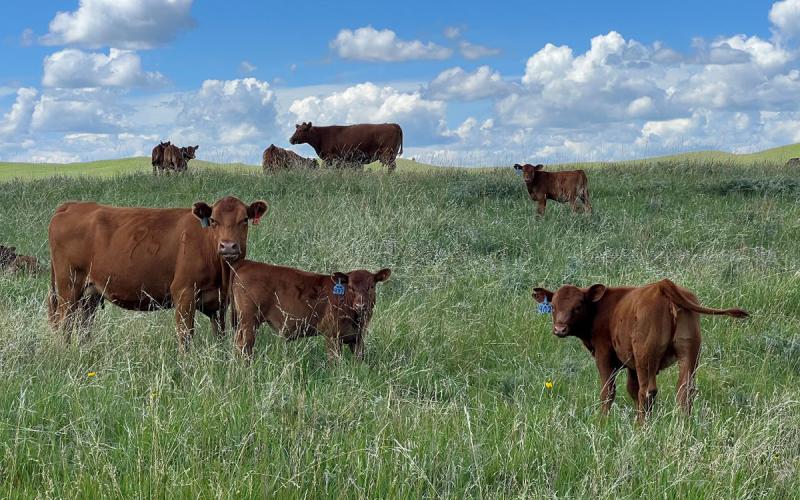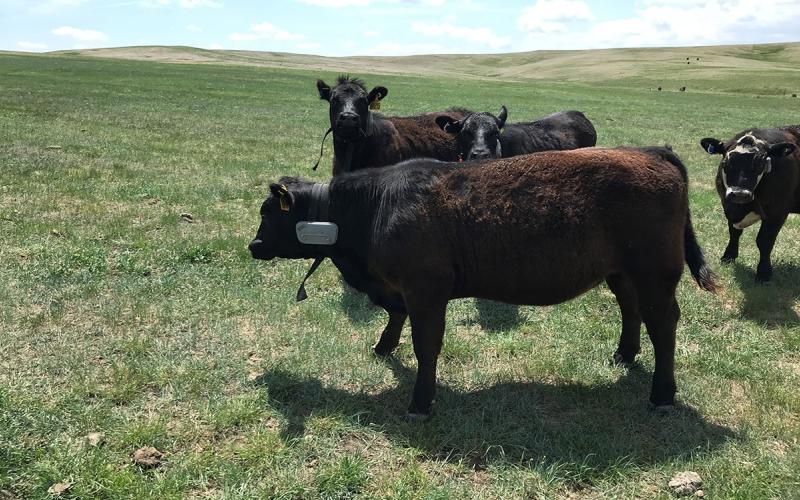Originally written with contributions by Gared Shaffer, former SDSU Extension Weeds Field Specialist.
The term weed can be broadly applied to any plant that is undesired or out of place based on certain criteria. It is important to understand that the word weed has become a general term with no universal definition, and many native plants are considered to be weeds depending on location. This becomes problematic in pasture management because producers can be misled regarding what a weed is or is not and what their responsibilities for control may be.
Some producers perceive that cattle eat primarily grass species and that only grass should dominate the pasture, leading to a conclusion that if a plant is not a grass, it is a weed and has no value to livestock production. This simplified approach can result in a broad-scale application of chemicals to control broadleaf plants in pastures. Producers should consult a variety of resources in order to assess whether a plant is truly a weed or whether it has some intrinsic value to the system or to livestock diets. These resources can be found at the end of this article.
Managing Weeds With Livestock
Researcher and author Kathy Voth is a leading expert in the emerging science of managing weeds with livestock. In Cows Eat Weeds, Voth (2010) outlines simple methods that any producer can implement to train cattle to eat a variety of weedy species, including many of the exotic species found on the South Dakota noxious weed list. With her simple techniques, she describes how one can train cattle to forage a variety of weeds previously thought to be non-palatable. This type of innovation can provide alternatives to producers struggling with the expense, scale, or timing of traditional weed control on rangeland and pasture. By utilizing grazing as a means of cultural control, producers have the potential to decrease input expenses while reaping the benefits of inexpensive weed control through animal nutrition.
Information on the palatability of individual species can be difficult to find and can oftentimes be contradictory. Location, time of year and time of day can influence a plant’s relative nutritional (or toxic) value. The relationship between toxins and nutrients in ruminant animals is complex, and in many cases livestock can successfully mix their own diets as long as enough variety is available (Kathy Voth pers. comm).
| Common Name (Scientific Name)2 |
TOXIC- AVOID |
|
Type4 |
eat it? |
Notes From Kathy Voth5 |
|---|---|---|---|---|---|
| Leafy spurge (Euphorbia esula) |
|
|
|
|
No adverse effects; Beliefs of causing diarrhea and mouth sores are unfounded; Literature citing adverse affects actually referred to a different species of spurge and has been miss-interpreted. |
| Canada thistle (Cirsium arvense) |
|
|
|
|
No adverse effects; Easiest weed to train on; Rumen microbes need 5-7 days to adapt during the training period. |
| Perennial sow thistle (Sonchus arvensis) |
|
|
|
|
No adverse effects; No toxins of concern. |
| Hoary cress (Cardaira draba) |
|
|
|
|
No adverse effects; Easy to train on. |
| Russian knapweed (Centaurea repens) |
|
|
|
|
No adverse affects; Easy to train on; High protein; Can offset other low quality forage; Some ranchers managing as forage. |
| Purple loosestrife (Lythrum salicaria) |
|
|
|
|
Should have no adverse effects; No listed toxins; Likely could train on it; Likely relatively short palatability; Probably similar to reed canary grass (phalaris arundinacea).7 |
| Salt cedar (Tamarix spp.) |
|
|
|
|
No trial information available.8 |
| Absinth wormwood (Artemisia absinthium) |
|
|
|
|
No listed toxins; Plant is high in terpenes; Supplement this with proteins; Vegetation high in protein can serve as supplement; Don't start with this weed, teach others first. |
| Black henbane (Hyoscyamus niger) |
|
|
Biennial |
Caution |
Caution: Wyoming rancher reported cattle ate it with no training and no adverse effects. It can cause hallucinations, coma, and death to humans. Voth recommends not specifically training on this plant. |
| Bull thistle (Cirsium vulgare) |
|
|
|
|
No adverse effects; No known toxins; Cattle trained on Canada thistle generally move to bull thistle and other thistles on their own. |
| Chicory (Cichorium intybus) |
|
|
Perennial |
|
Cattle consumed on their own after being trained on other weeds. |
| Common burdock (Arctium minus) |
|
|
|
|
No adverse effects; No toxins of concern; Voth has not trained on this, but other ranchers have used her system successfully. |
| Common mullein (Verbascum thapsus) |
|
|
|
|
No specific targeted training on this plant. Cattle trained on other species began eating it on their own. Cattle seem to select for it when in flower. Cattle bite off the flower stems which then regrow, curving out from the original stem. |
| Common tansy (Tanacetum vulgare) |
|
|
|
|
Do not train on this plant; Not edible and it is preferable if cattle avoid it. Do not worry if cattle take some in, they can mix their own diets. |
| Dalmatian toadflax (Linaria dalmatica) |
|
|
|
|
No adverse effects; Colorado herd trained in 2008 still eating this; All plants in 500 acre pasture were bitten off in 2012; Graze early and often, cattle will learn to graze after flowering. Protein content drops after flowering. |
| Diffuse knapweed (Centaurea diffusa) |
|
|
Perennial |
|
No adverse effects; Cattle prefer this plant; Trial herd were trained to eat it when plant was bolting and when crude protein dropped to 7%; When combined with biocontrol, trained herds can reduce populations of this weed. |
| Field bindweed (Convolvulus arvensis) |
|
|
|
|
Cattle consumed on their own after being trained on other weeds; Bindweed is a nitrate accumulator, but no adverse effects reported. |
| Giant knotweed (Polygonum sachalinense) |
|
|
|
No trial information available.8 | |
| Hounds tongue (Cynoglossum officinale)6 |
|
|
|
|
Toxic; Do not train on this plant; Not edible; Causes liver problems resulting in wasting; Trial goats have acclimated to it; Voth speculates that cattle trained on other weeds may be able to mix diets successfully but no specific trial work has been performed. |
| Musk thistle (Carduus nutans) |
|
|
Perennial |
|
No adverse effects; No specific training trials; Cattle move to it naturally after training on Canada thistle; Cattle could be specifically trained on this. |
| Ox eye daisy (Leucanthemum vulgare) |
|
|
|
|
No adverse effects; Rancher trained on it successfully. |
| Phragmites (Phragmites australis) |
|
|
|
|
Should have no adverse affects; No listed toxins; Likely could train on it; Likely relatively short palatability....probably similar to reed canary grass (phalaris arundinacea).7 |
| Plumeless thistle (Carduus acanthoides) |
|
|
|
|
Edible; No specific experience; Should be similar to bull or musk thistle. |
| Poison hemlock (Conium maculatum)6 |
|
|
|
|
Toxic; Don't train on this plant; Many report livestock do eat this plant, but as of yet it is poorly understood; Cattle may be able to select dietary offsets, but Voth recommends avoiding specific training to the plant. |
| Puncturevine (Tribulus terrestris) |
|
|
|
|
Toxic; Do not train on this plant; Can lead to photosensitivity; Large quantities can lead to trouble walking and death. |
| Scotch thistle (Onopordum acanthium) |
|
|
|
|
No adverse effects; Train when plant is small because can be difficult for cattle to bite adult sized plants. |
| Spotted knapweed (Centaurea maculosa) |
|
|
Perennial |
|
No adverse effects; Easy to train; Cattle utilize as a base forage; July grazing is preferred; protein is highest while native forb protein is low. |
| Sulfur cinquifoil (Potentilla) |
|
|
|
|
No trial information available.8 |
| St. Johnswort (Hypericum perforatum)6 |
|
|
|
|
Toxic; Do not train on this plant; Can lead to photosensitivity; Cattle may be able to select dietary offsets; Voth recommends avoiding specific training. |
| Yellow toadflax (Linaria vulgaris) |
|
|
|
|
No adverse effects; Cattle do well, most plants grazed. |
Notes:
- Source: Kathy Voth at the request of the author. Information on palatability based on literature reviews, field trials, and observation. Information not independently verified by SDSU.
- South Dakota state and locally noxious weeds lists are available at the South Dakota Department of Agriculture website.
- Source: SD Dept. of Ag
- Source: USDA Plants database
- Based on literature, field trials, observation, and reported results from ranchers who've attempted to train cattle with Voth's system unless otherwise indicated.
- Additional information available in Plants that Poison Livestock in the Great Plains Area. See references at end of this chapter.
- Limited trial information available for conclusive statements.
- No specific information available.
Additional Resources
- Fuhlendorf, S.D., D.M. Engle, C.M. O’Meilia, J.R. Weir, and D.C. Cummings. 2009. Does herbicide weed control increase livestock production on non-equilibrium rangeland? Agriculture, Ecosystems and Environment. 132:1-6.
- Johnson, J.R. and G.E. Larson. 2007. Grassland plants of South Dakota and the Northern Great Plains. South Dakota State University, Brookings, SD. B 566 (revised). August 2007. 288 pp.
- Northern Great Plains Floristic Quality Assessment Panel. 2001. Floristic quality assessment for plant communities of North Dakota, South Dakota (excluding the Black Hills), and adjacent grasslands. Jamestown, ND: Northern Prairie Wildlife Research Center Online. (Version 26JAN2001).
- Plants that poison livestock in the Great Plains area. 69 pp. Available from: Black Hills Resource Conservation and Development Association, Inc. P.O. Box 8142, Rapid City, SD 57709.
- South Dakota Department of Agriculture. 2009. South Dakota Weeds. 235 pp. South Dakota Department of Agriculture. Pierre, SD.
- South Dakota Department of Agriculture. Weed & Pest Control.
- South Dakota Legislature, Legislative Research Council. Codified Laws: Weed & Pest Control.
- USDA/NRCS. PLANTS Database.
- Voth, K. 2010. Cows Eat Weeds: How to turn your cows into weed managers. Livestock For Landscapes, Loveland, CO. 131 pp.

